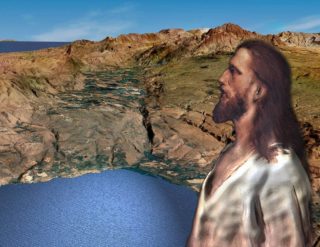
Intro to Matthew
Most Jewish Story of Jesus
If we’ve got the chutzpah to add extra books to the Jewish Bible, creating a Christian Bible, Matthew is probably the best place to start.
It’s the most Jewish-friendly story of Jesus. It’s more Jewish than any of the other three Gospels—Mark, Luke, and John.
Matthew works harder than any of the other writers to convince Jews that Jesus is the Messiah they’ve been waiting for. Among the other three Gospels, Mark reports the most Messiah-related prophecies that Jesus supposedly fulfilled: 30.
Matthew nearly doubles that number. He quotes 57.
A Bridge to the New Testament
That helps make Matthew the perfect bridge from the last book of prophecy in the Jewish Bible, Malachi, which leaves Jews anticipating the Messiah that he says is coming: “I’m sending an advance person to prepare the path ahead of me. . . . He’ll show up suddenly. The LORD of everyone assures you that the messenger you love is coming” (Malachi 3:1).
Matthew says John the Baptist was the messenger who prepared the way for the Lord and Jesus is the Messiah who came and taught at the Temple.
Matthew also shows more sensitivity to tradition-minded Jews than the other Gospels. For example, instead of talking about the kingdom of God, as the other writers do, he usually calls it the kingdom of heaven.
He does so because many Jews then and now shy away from using the name of God. It’s a bit like why a kindergarten teacher would shy away from chewing tobacco in front of the kids and then spitting the juice in a can across the room held by a kid sitting in time-out.
Matthew’s Respect for G-d’s Name
Also, Jews considered it disrespectful to even write God’s name; today many Jews write the name as G-d.
“Disrespectful” is the least that parents would say about the kindergarten teacher. But the disgust they would feel toward the teacher is perhaps a tad like the disgust some Jews felt about others who treated God and their traditions with disrespect.
Matthew tries gently and respectfully to convince his fellow Jews that Jesus is the Savior God promised to send.
Matthew says John the Baptist asked Jesus, “Are you the one we’ve all been waiting for?” (Matthew 11:3).
Jesus told John, “The blind can see. The crippled can walk. Lepers are cleansed and free of the disease. The deaf can hear. The dead come back to life. The poor are getting good news for a change” (Matthew 11:5).
That’s a yes.
Writer
The writer is anonymous, like all four Gospels about Jesus. The first person on record to credit Matthew, one of Jesus’s 12 disciples, was Papias of Hierapolis (about AD 100-140), a bishop from what is now Turkey.
This Gospel is the only one to report that Matthew was the tax collector Jesus invited to become one of the 12 apostles (Matthew 9:9). The other Gospels say Levi was the taxman.
Whoever wrote the Gospel, most scholars today agree he was a Jewish man who used the Gospel of Mark as one major source of information. Nearly half of the stories and teaching in Matthew also show up in Mark. Luke seems to draw from Mark, too, most scholars say.
Timeline
Matthew covers the lifetime of Jesus, from about 4 BC to AD 33. Most Bible experts say the author wrote Matthew sometime after Romans crushed the Jewish rebellion for independence and, in AD 70, leveled Jerusalem. That took the world’s only Jewish Temple that has never been rebuilt. Many date the book to the AD 80s.
By comparison, that would be like someone today writing a biography of someone who died about 50 years ago.
Most scholars say Mark’s Gospel came first, possibly in the AD 60s.
The oldest nearly complete copies of Matthew date to the AD 300s. Fragments date to as early as the late AD 100s, about a century after Matthew likely was written.
 Location
Location
Most of this story about Jesus takes place in the rolling hills of Galilee, a territory in what is now northern Israel, between the Mediterranean Sea and a lake called the Sea of Galilee. The climax of the story—Jesus’s crucifixion and resurrection—takes place farther south, in Jerusalem.
Intended Readers
One of many theories is that Matthew was written by a Jewish man in Antioch of northern Syria, primarily for believers there.
“It was here, in Antioch, that people started calling the believers Christians” (Acts 11:26).
The Antioch church was multiracial, mixing Jewish followers of Jesus with non-Jews. It was also the first church on record to say that believers didn’t have to follow Jewish rules about circumcision or nonkosher food. Tradition-minded Jews called their belief system heresy. But in time, the rest of the world came to call it Christianity.





